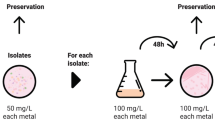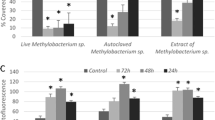Abstract
THE decomposition of pyrite by an acid solution of ferric sulphate may be summarized by the reactions,  In conditions whereby ferric ions are continuously regenerated and the sulphur liberated in the first reaction is oxidized to sulphuric acid by an alternative and more rapid process than represented in the second reaction, the decomposition of pyrite may become rapid and even catastrophic. Such conditions can be provided in the presence of actively growing bacteria of the genera Ferrobacillus and Thiobacillus. These common and widely distributed aerobic and obligatory autotrophic organisms obtain the energy required for their growth from the reactions,
In conditions whereby ferric ions are continuously regenerated and the sulphur liberated in the first reaction is oxidized to sulphuric acid by an alternative and more rapid process than represented in the second reaction, the decomposition of pyrite may become rapid and even catastrophic. Such conditions can be provided in the presence of actively growing bacteria of the genera Ferrobacillus and Thiobacillus. These common and widely distributed aerobic and obligatory autotrophic organisms obtain the energy required for their growth from the reactions,  The activities of these organisms are responsible for the production of highly acid ferruginous mine-waters and can give rise to considerable problems of corrosion of mining equipment1. Growth of the bacteria on pyritic material in storage and display cases in museums has resulted in the disintegration and loss of large numbers of valuable mineralogical and fossil specimens. This poses a difficult problem in conservation. Some success has been achieved in combating the phenomenon at the British Museum (Natural History) by washing specimens in an aqueous solution of a proprietary disinfectant (personal communication from P. B. Embrey). The treatment is, however, tedious and inappropriate to certain classes of specimen (for example, specimens in which the interest lies in water soluble inclusions in a pyritic matrix). In many cases where specimens are required from time to time for research purposes, the covering of the original surface by a protective lacquer is also unacceptable.
The activities of these organisms are responsible for the production of highly acid ferruginous mine-waters and can give rise to considerable problems of corrosion of mining equipment1. Growth of the bacteria on pyritic material in storage and display cases in museums has resulted in the disintegration and loss of large numbers of valuable mineralogical and fossil specimens. This poses a difficult problem in conservation. Some success has been achieved in combating the phenomenon at the British Museum (Natural History) by washing specimens in an aqueous solution of a proprietary disinfectant (personal communication from P. B. Embrey). The treatment is, however, tedious and inappropriate to certain classes of specimen (for example, specimens in which the interest lies in water soluble inclusions in a pyritic matrix). In many cases where specimens are required from time to time for research purposes, the covering of the original surface by a protective lacquer is also unacceptable.
This is a preview of subscription content, access via your institution
Access options
Subscribe to this journal
Receive 51 print issues and online access
$199.00 per year
only $3.90 per issue
Buy this article
- Purchase on Springer Link
- Instant access to full article PDF
Prices may be subject to local taxes which are calculated during checkout
Similar content being viewed by others
References
Colmer, A. R., and Hinkle, M. E., Science, 106, 253 (1947).
Postgate, J. R., Lab. Practice, 15, 1239 (1966); 18, 286 (1969).
Silverman, M. P., and Lundgren, D., J. Bact., 77, 642 (1959).
Author information
Authors and Affiliations
Rights and permissions
About this article
Cite this article
BOOTH, G., SEFTON, G. Vapour Phase Inhibition of Thiobacilli and Ferrobacilli: A Potential Preservative for Pyritic Museum Specimens. Nature 226, 185–186 (1970). https://doi.org/10.1038/226185a0
Received:
Revised:
Issue Date:
DOI: https://doi.org/10.1038/226185a0
Comments
By submitting a comment you agree to abide by our Terms and Community Guidelines. If you find something abusive or that does not comply with our terms or guidelines please flag it as inappropriate.



